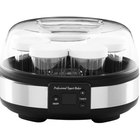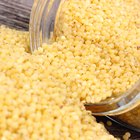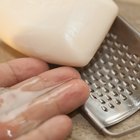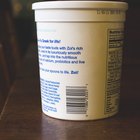
If you have ever been disappointed by a batch of homemade yogurt's runny consistency, there are several measures you can take to make sure it turns out thick and creamy the next time. Using the right techniques and fresh yogurt starter are only the beginning. If you need to repair store-bought or homemade yogurt in a hurry, a couple quick and simple fixes will help to firm it up.
Strain
A sure way to fix runny yogurt is to strain it as if you were making yogurt cheese. Line a colander or strainer with a clean dish towel or cheesecloth. Place the cloth-lined strainer over a bowl. Dump or spoon the yogurt into the strainer. Excess whey, the watery part of yogurt, will drip through the cloth into the bowl. Let the yogurt drain for 30 to 60 minutes until it has the consistency you want. This method works best for yogurt that has been refrigerated or purchased.
Thicken
If you made your own yogurt and it is still warm, adding unflavored gelatine may thicken it. Add 1 to 3 teaspoons of gelatine per jar and whisk it thoroughly into the warm yogurt: 1 teaspoon for an 8-ounce jar, 2 for a pint jar and 3 teaspoons for a quart jar. There are no hard and fast rules for how long this takes. Keep whisking until the yogurt starts to thicken to the consistency you want. Scrape the bottom of the jar often to distribute the gelatine particles throughout the yogurt. Failure to incorporate the gelatine throughout the product may result in a gummy layer on the bottom and a runny layer at the top of the jar.
Add
Add some cream to the milk used in making homemade yogurt to reduce the chances of having a runny product. Stirring some nonfat dry milk into the fresh milk you are using may also help prevent runniness.
Technique
Use a fresh batch of starter if your homemade yogurt is consistently runny. The lactobacillus organisms that ferment and create yogurt lose their strength over time. Buy fresh starter once a month. Discard old starter if you have not made yogurt in a while. Keep powdered yogurt starters cool and dry when you are not using them. Incubate your homemade yogurt at a high enough temperature and for a sufficient length of time to get a creamy consistency. Do not jostle or shake your yogurt while it is incubating or cooling. Put cooled jars in the refrigerator or in the freezer briefly to firm up a thin batch.
Related Articles

How to Mix Yogurt With Unflavored ...
How to Save Homemade Yogurt That Didn't ...

Instructions for the Euro Cuisine ...

Kefir Substitute

What Happens When You Heat Up Greek ...

How to Substitute for Yogurt in Indian ...

How to Make Green Tea Frappuccino

Cooking Yogurt Without Curdling It

Cooking Yogurt Without Curdling It

How to Make Yogurt Shampoo

What Is "Cultured Cream"?

How to Sweeten Plain Yogurt

How to Ferment Whole Grains

Greek Yogurt as a Replacement for Sour ...

How to Make Queso Fresco

How to Make Bar Soap Into Liquid Soap ...

How to Freeze Greek Yogurt

How to Make Tomato Jelly

How to Ferment Coconut

Can You Bake Greek Yogurt?
References
- Kitchen Stewardship: Troubleshooting Guide for Homemade Yogurt: Five "Runny Yogurt" Fixes
- Kitchen Stewardship: How to Make Whey and Yogurt Cheese
- Nourished Kitchen: Why Your Yogurt Isn't Turning Out: How Do I Make My Yogurt Thicker?
- Kitchen Stewardship: How to Make Perfect Thick, Creamy Yogurt: Step by Step Instructions for Adding Gelatine
Writer Bio
Susan Kerr began her writing career as a food columnist in 1987 before moving to business journalism as a reporter and managing editor in the Penn State area. Since then, Kerr has contributed content to military-related magazines, not-for-profit websites and other online media. In addition, she writes a weekly column for her hometown newspaper
Photo Credits
Creatas Images/Creatas/Getty Images